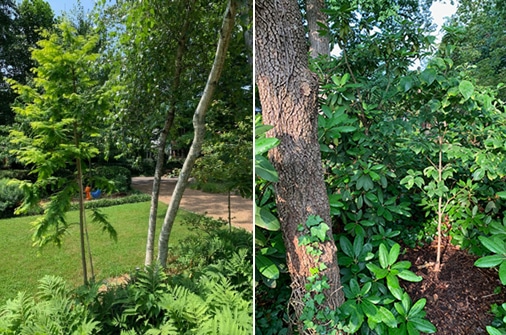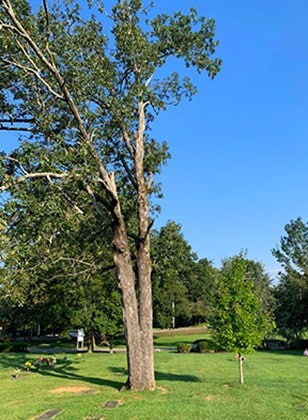PLANNING AHEAD
PLANTING REPLACEMENT TREES
The tree on the right was planted in anticipation of the larger dogwood near the house being removed at some time in the future.
Anyone who knows me can tell you that I am a planner. One former colleague liked to joke “Garry probably knows what he’s having for dinner a week from Tuesday.” I don’t believe I’ve always been this way. When I was in college, I would buy toothpaste when I ran out of toothpaste. Now I’ve got a stash of all toiletries from Q-tips to dental floss waiting on the bench when something runs out. I didn’t make it far in Boy Scouts but most know their motto is “Be Prepared”. All through my professional career, I’ve secretly had a fear of not being prepared or not having what I needed to do the job.
Just where is all this rambling going? Why trees of course! I’m a shade lover. Not a fan of summer heat or even sun for that matter (unless we’re at the pool or the beach). We are blessed to live in a neighborhood that is also home to some of the greatest trees in Knoxville. Since I’m an old fart now and knowing that most of these trees are oaks, I’ve got a hopeful feeling that they’ll still be putting out leaves and providing shade after I’ve gone to the great garden beyond. BUT…..that doesn’t stop me from thinking and planning ahead.

I’ve gotten into the habit lately of planting replacement trees quite near some that I think may check out before I do. Urban foresters and arborists may find fault with this practice but my mindset is that the replacement tree can acclimate to the soil, and get some serious roots established as the declining tree heads into the ninth inning. While it may be true that the replacement tree will be slow to develop given some root competition and limited sun. However, once the older tree gives up the ghost and is removed, it won’t be as much of a shock as that of a completely open void in the garden. Plus, since the newbie is already established with regard to some nice root development, it will typically display a burst of growth now that it receives a healthy dose of solar radiation.
I’m already hearing the question from some readers. “How does one remove an established tree without harming another adjacent tree?” My answer would be to do your best to drop the older tree in a place and direction where it won’t crush or rip branches from the one on deck (baseball analogy). If you can’t do this yourself, find a reputable arborist or urban forester to do the job for you. These guys have loads of experience and will have no problem steering clear of the younger tree.
I’m not going for length in this writing but merely offering a snippet of garden advice for you to consider.







